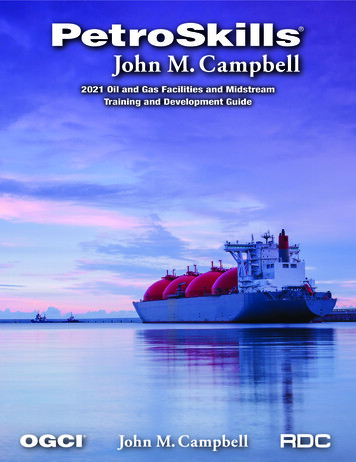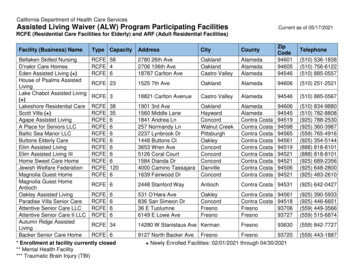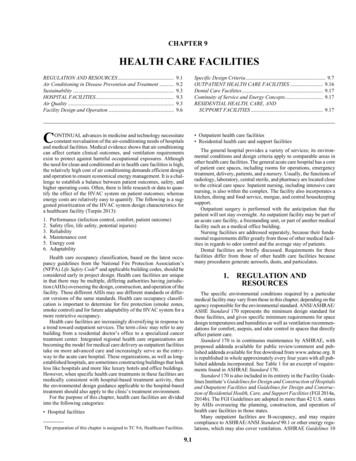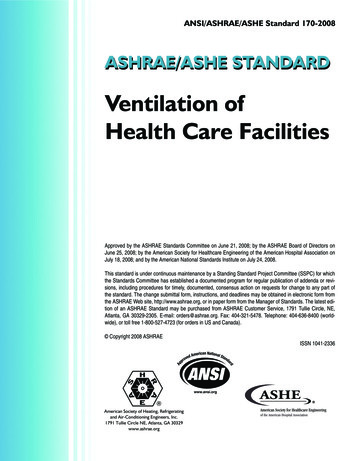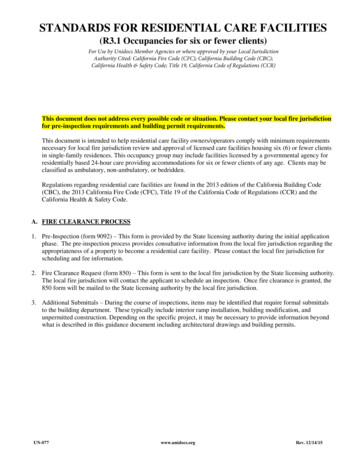
Transcription
STANDARDS FOR RESIDENTIAL CARE FACILITIES(R3.1 Occupancies for six or fewer clients)For Use by Unidocs Member Agencies or where approved by your Local JurisdictionAuthority Cited: California Fire Code (CFC); California Building Code (CBC);California Health & Safety Code; Title 19, California Code of Regulations (CCR)This document does not address every possible code or situation. Please contact your local fire jurisdictionfor pre-inspection requirements and building permit requirements.This document is intended to help residential care facility owners/operators comply with minimum requirementsnecessary for local fire jurisdiction review and approval of licensed care facilities housing six (6) or fewer clientsin single-family residences. This occupancy group may include facilities licensed by a governmental agency forresidentially based 24-hour care providing accommodations for six or fewer clients of any age. Clients may beclassified as ambulatory, non-ambulatory, or bedridden.Regulations regarding residential care facilities are found in the 2013 edition of the California Building Code(CBC), the 2013 California Fire Code (CFC), Title 19 of the California Code of Regulations (CCR) and theCalifornia Health & Safety Code.A. FIRE CLEARANCE PROCESS1. Pre-Inspection (form 9092) – This form is provided by the State licensing authority during the initial applicationphase. The pre-inspection process provides consultative information from the local fire jurisdiction regarding theappropriateness of a property to become a residential care facility. Please contact the local fire jurisdiction forscheduling and fee information.2. Fire Clearance Request (form 850) – This form is sent to the local fire jurisdiction by the State licensing authority.The local fire jurisdiction will contact the applicant to schedule an inspection. Once fire clearance is granted, the850 form will be mailed to the State licensing authority by the local fire jurisdiction.3. Additional Submittals – During the course of inspections, items may be identified that require formal submittalsto the building department. These typically include interior ramp installation, building modification, andunpermitted construction. Depending on the specific project, it may be necessary to provide information beyondwhat is described in this guidance document including architectural drawings and building permits.UN-077www.unidocs.orgRev. 12/14/15
B. GENERAL REQUIREMENTS1. Address numbers shall be clearly posted on the house and visible from the street. Numbers shallcontrast with their background and shall be sufficiently illuminated for viewing at night. Illuminationmay be either internal or external. [2013 CFC 505.1]2. Garages – If a garage is attached to the residence, the door between the residence and the garage shallbe maintained to be self-closing and self-latching. The door shall be fire rated or a minimum 13/8 inchthick solid wood door. The garage shall not be used for sleeping purposes. There shall be no additionalopenings from the garage into any portion of the residence. Maintain the garage in a neat, orderlyfashion with minimal combustible storage. Clearance between the water heater and any combustiblematerial shall be maintained in accordance with the manufacturer’s specifications and the heater’slisting. Typically, 18 inches is the minimum clearance required. [2013 CBC 406.3.4]3. Stairway Doors – A non-rated door may be used to provide the required floor separation to preventsmoke migration between floors. The door shall have the equivalent construction of ½ inch gypsumwallboard on one side of the wall studs (e.g., 20 minute rated assembly or 13/8 inch solid core door). Thedoor shall be tightfitting, positive latching, smoke gasketed, and automatic closing upon activation of thesmoke detector. This requirement will be waived if the building is provided with fire sprinklers or has atleast one exterior exit from each floor occupied by clients. [2013 CBC & (CFC appendix) 425.8.7]4. Exits - There shall be a minimum of two exits from the dwelling. Exits shall be 36 inches wide and 6feet, 8 inches tall and provide a 32-inch clear opening. Exit doors shall be remote from each other, andshall not pass through kitchens, garages, storerooms or closets and shall not pass through more than oneintervening room. [2013 CFC & CBC 1015.7 and Appendix 425.8.2.1 and 425.8.3.4]o No bed, chair, equipment, storage materials or any other item shall be placed in any manner thatwould block or obstruct the required width of an exit. This shall include the exterior sidewalksleading from the exits to the public way. [Title 19, Div 1, 3.11(a-d)]o A floor or landing shall be provided on each side of every exit door. The floor or landing shall notbe more than ½ inch lower than the threshold of the doorway. [CBC 1008.1.7] The exterior floor or landing shall have a minimum width of 44 inches and be at least as wideas the opening.5. Ramps - Homes may require ramps. If the exterior landing has more than ½ inch step down, a rampshall be provided. The slope of the ramp shall not be steeper than 1 inch vertical to 12 inches horizontalwith a minimum clearance width of 36 inches. As an example, a 6-inch drop from a landing wouldrequire a 6-foot long ramp. Ramps shall have a non-skid surface. [2013 CFC 1010 and 1022,California Residential Code 311.8]o Handrails shall be provided if ramps have more than a 6 inch rise. The top of the handrail shall notbe less than 34 and not more than 38 inches in height. [CBC 1010.9,1012.2]6. Fire extinguisher - One 2A:10B:C rated fire extinguisher shall be mounted in a visible and accessiblelocation with the top of the extinguisher no higher than 5 feet. The maximum travel distance to anextinguisher shall not be more than 75 feet. Fire extinguishers shall be serviced annually with a servicetag attached. [2013 CFC 906.1]7. Heating appliances - Every heating appliance which does not have protective features incorporated intothe design shall be provided with guards that will provide protection against the ignition of clothing andcombustible materials. [2013 CFC 603.5.1]UN-077www.unidocs.orgRev. 12/14/15
8. Flammable liquids - Storage and use of more than 5 gallons of flammable liquids requires a permit.Such liquids may not be stored inside of the residence. [2013 CFC 105.6.16]9. Permits approved by the Building Official shall be presented to the inspector for all additions, remodelsor conversions.10. Smoke and Carbon Monoxide alarms and detectorso A smoke alarm shall be installed in each sleeping room and at a point centrally located in thehallway or area giving access to the sleeping areas. Additional detectors may be required for vaultedceilings adjacent to the hallway. Detectors shall sound an alarm audible in all sleeping areas of theunit in which they are located. [CBC 907.2.11.2]o Smoke alarms shall be interconnected in such a manner that the activation of one alarm will activateall of the alarms. Listed wireless alarms are allowed. [2013 CBC 907.2.11.3]o In newly classified group R3.1 occupancies smoke alarms shall receive their primary power from thebuilding wiring where such wiring is served from a commercial source and shall be equipped with abattery backup. [2013 CBC 907.2.11.4]o Carbon monoxide alarms shall be installed in all existing group R occupancies. The carbonmonoxide alarms shall be listed as complying with UL 2034 and be installed and maintained inaccordance with NFPA 720 and the manufacturer’s instructions. [2013 CBC 420.6.2]SEE EXAMPLE ON PAGE 6 FOR DETECTOR PLACEMENT11. Sleeping rooms used by non-ambulatory clients shall have access to at least one required exit whichconforms to one of the following: [2013 CBC & (CFC appendix) 425.8.3.2]o Exits through a corridor/hallway or area and into a sleeping room (in the immediate area), which hasan exit directly to the exterior. Bedroom doors used as exits shall have exit signs and shall not beprovided with a lock or latch preventing egress. The hallway shall be separated from the commonareas by a solid wood door not less than 1 3/8 inch in thickness, maintained self-closing or shall beautomatic closing by actuation of a smoke detector.o Through a corridor/hallway serving the sleeping area, which exits directly to the exterior. Thehallway shall be separated from the common areas by a solid wood door not less than 1 3/8 inch inthickness, maintained self-closing or shall be automatic closing by actuation of a smoke detector.o Direct from the bedroom to the exterior.o Exit through an adjoining bedroom that exits to the exterior. (No private locks on bedroom doors areallowed, if exiting through bedroom).SEE EXAMPLE DIAGRAMS ON PAGES 9-12UN-077www.unidocs.orgRev. 12/14/15
C. Bedridden Fire Clearance : Additional Requirements: In all facilities housing a bedridden client, smoke alarms shall receive their primary power from thebuilding wiring and be equipped with a battery backup. Smoke alarms shall be electricallyinterconnected so as to cause all smoke alarms to sound a distinctive alarm signal upon actuation of anysingle smoke alarm. Such alarm signal shall be audible throughout the facility at a minimal level of 15db above ambient noise level. These devices need not be interconnected to any other fire alarm device,have a control panel, or be electrically supervised or provided with emergency power. [2013 CFC1103.8.4] R3.1 occupancies that are not provided with an approved automatic sprinkler system are only allowedclearance for 1 bedridden client. [2013 CFC 903.2.8] Non-sprinklered R3.1 occupancies housing a bedridden client shall have all of the following:o Client sleeping room shall have a direct exit to the exterior.o Doors to a bedridden client’s sleeping room shall be of a self-closing, positive latching 1 3/8 inchsolid wood door. Such doors shall be provided with a gasket so installed as to provide a sealwhere the door meets the jam on both sides and across the top. Doors shall be maintained selfclosing or shall be automatic closing by actuation of a smoke detector. [2013 CBC 716.5.9.2]o Group R3.1 occupancies housing a bedridden client shall not have a night latch, dead bolt,security chain or any similar locking device installed on any interior door leading from abedridden client’s sleeping room to any interior area such as a corridor, hallway and or generaluse areas of the residence in accordance with chapter 10.o The exterior exit door to a bedridden client’s sleeping room shall be operable from both theinterior and exterior of the residence.o Every required exit doorway from a bedridden client sleeping room shall be of a size as to permitthe installation of a door not less than 3 feet in width and not less than 6 feet 8 inches in height.When installed in exit doorways, exit doors shall be capable of opening at least 90 degrees andshall be so mounted that the clear width of the exit way is not less than 32 inches.o Note: a sliding glass door can be used as an exterior exit doorway as long as it is operable fromthe inside and outside and the clear width of the exit way is not less than 32 inches. [2013 CBC & (CFC appendix) 425.8.3.3] In R3.1 occupancies housing a bedridden client, the sleeping room shall not be located above or belowthe first floor. [2013 CBC & (CFC appendix) 425.3.2] Exception: Clients who become bedridden as a result of a temporary illness as defined in Health andSafety Code, Sections 1566.45, 1568.0832, and 1569.72. A temporary illness is an illness which persistsfor 14 days or less. A bedridden client may be retained in excess of the 14 days upon approval by theDepartment of Social Services and may continue to be housed on any story in a Group R 3.1 occupancyclassified as a licensed residential facility. [2013 CBC & (CFC appendix) 425.3.2]UN-077www.unidocs.orgRev. 12/14/15
SafetyGas Appliances:Enclose gas fired water heaters andfurnaces to protect against ignition ofclothing and other combustible materials.[2013 CFC 603.5]Back Yard Gate:Side gates that are part of the exit path out to apublic way must meet exit door requirements.An example of a simple, single action set-upwould be wire/string with a handle at the client’slevel that is attached to the normal gate latch. Ifthe gate opens inward a handle at clients’ level isalso required.[2013 CBC & (CFC appendix) 425.8.8]Flammable Liquids:Storage and use of more than 5 gallons ofgasoline or other flammable liquid requires apermit.[2013 CFC 105.6.16][2013 CBC 406.3.4]UN-077www.unidocs.orgRev. 12/14/15
Smoke Detector PlacementProvide a residential type smoke detectorapproved by the State Fire Marshalfor all areas.Inside and directly outside all bedrooms,sleeping rooms and rooms occupied by clientsthere must be a smoke detector.Smoke detectors are not required in kitchensand bathrooms.ceilingThe smoke detector should be mounted onthe ceiling. Do not mount closer than 6inches to the corner of the ceiling and thewall. In special cases where the smokedetector must be mounted on the wall, donot mount closer than 6 inches to theceiling or further than 12 inches away.[2013 CFC 907.2.11.2]UN-077wallwww.unidocs.orgRev. 12/14/15
Fire ExtinguishersAll fire extinguishers shall be mounted between 3 and 5 feet above the floor. Thebottom of the extinguisher must have a 4 inch clearance from the floor.Fire extinguishers must be visible and accessible.[2013 CFC 906.5, 906.9, 906.9.1, CCR Title 19, Div. 1, §567.6]Provide a fire extinguisher, rated at least 2A:10B:C, and be sure to installit correctly. Your fire extinguisher needs to be serviced annually, andafter discharge, by a licensed technician and must have a State FireMarshal Service Tag.State Fire Marshal Service Tag:Punched date indicates date of servicenot expiration date. The service isgood for one year from punched date.A new extinguisher is good for oneyear from purchase date (mustmaintain the store receipt.)2UN-077The Fire Extinguisher Rating/Classification,such as 2A:10B:C, may be found near the UL labelwww.unidocs.orgRev. 12/14/15
Fire Alarm Strobe and Manual Pull Stations Notification appliance alarms are no longer required in most newly classified R3.1 facilities, yet thosealready in existence must be maintained. [2013 CFC section 907.8.5] Protective Social Care facilities which house persons who are hearing impaired, shall be provided withnotification appliances for the hearing impaired installed in accordance with NFPA 72 and which shallactivate upon initiation of the fire alarm system or the smoke alarms. [2013 CFC section 907.5.2.3.5] Protective social care facility defined: A facility housing persons, who are referred, placed or caused tobe placed in the facility, by any governmental agency and for whom the services, or portion thereof, arepaid for by any governmental agency. These occupancies shall include, but are not limited to, thosecommonly referred to as “assisted living facilities,” “social rehabilitation facilities,” “certified familycare homes,” “out-of-home placement facilities,” and “half-way houses.” [2013 CFC chapter 2definitions]Two Exits RequiredA sliding glass door may be used forone of the two exits. [2013 CBC &(CFC appendix) 425.8.3.3]On Sliding Doors only themanufacturers locking hardware isallowed. No additional locks may beadded.UN-077www.unidocs.orgRev. 12/14/15
Non-Ambulatory Egress Arrangements4. Sleeping rooms used by non-ambulatory clients shall have access to at least one requiredexit which conforms to one of the following: [2013 CBC & (CFC appendix) 425.8.3.2]A. Exits through a corridor/hallway or area and into a sleeping room (in the immediatearea), which has an exit directly to the exterior. Bedroom doors used as exits shallhave exit signs and shall not be provided with a lock or latch preventing egress. Thehallway shall be separated from the common areas by a solid wood door not less than1 3/8 inch in thickness, maintained self-closing or shall be automatic closing byactuation of a smoke detector.Example A:From Room to Hallway to Room and OutBathroomBathroomProviderBedroomBedroom2 non-ambsBedroom2 non-ambsBedroom2 non-ambsLivingRoomKitchenUN-077www.unidocs.orgRev. 12/14/15
B. Through a corridor/hallway serving the sleeping area, which exits directly to the exterior. Thehallway shall be separated from the common areas by a solid wood door not less than 1 3/8 inchin thickness, maintained self-closing or shall be automatic closing by actuation of a smokedetector.Example B:From Room to Hallway to OutsideBathroomBathroomProviderBedroomBedroom2 non-ambsBedroom2 non-ambsBedroom2 non-ambsLivingRoomKitchenUN-077www.unidocs.orgRev. 12/14/15
C. Direct from the bedroom to the exterior.Example C:Direct Exits to ExteriorBathroomBathroomProviderBedroomBedroom2 non-ambsBedroom2 non-ambsBedroom2 non-ambsKitchenUN-077LivingRoomwww.unidocs.orgRev. 12/14/15
D. Exit through an adjoining bedroom that exits to the exterior. (No private locks on bedroomdoors are allowed, if exiting through bedroom).Example D:From Room to Room to OutsideBathroomBathroomProviderBedroomBedroom2 non-ambsBedroom2 ambulatoryBedroom2 non-ambsLivingRoomKitchenUN-077www.unidocs.orgRev. 12/14/15
residentially based 24-hour care providing accommodations for six or fewer clients of any age. Clients may be . the 2013 California Fire Code (CFC), Title 19 of the California Code of Regulations (CCR) and the California Health & Safety Code. A. FIRE CLEARANCE PROCESS . Title 19, California Code of Regulations (CCR) UN-077 www.unidocs.org .

